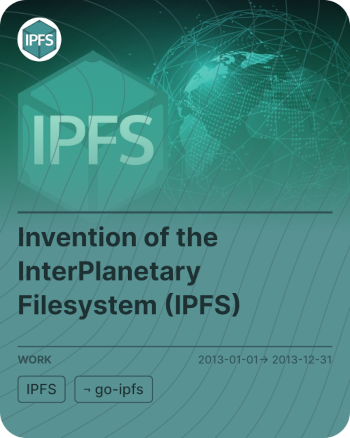What are hypercerts?
Hypercerts are a new token standard for tracking and rewarding positive impact.
Each hypercert represents a unique impact claim capturing the following information:
- a scope of work and its corresponding scope of impact
- a set of time frames for both the work and its impact
- a set of contributors – the organization or people behind the work
- a set of rights you get by owning a hypercert
The hypercert itself is an ERC-1155 semi-fungible token with the information above stored as metadata on IPFS. Here’s an example.
Hypercert example
Graphic representation

Supplementary information (metadata)
- Title of hypercert: Invention of the InterPlanetary Filesystem (IPFS)
- Description: The InterPlanetary File System (IPFS) is a set of composable, peer-to-peer protocols for addressing, routing, and transferring content-addressed data in a decentralized file system.
- Link: ipns://ipfs.tech/
Hypercert dimensions (metadata)
- Set of contributors: 0xb794f5ea0ba39494ce839613fffba74279579268 (example Ethereum address)
- Scope of work: IPFS ∧ ¬ go-ipfs
- Time of work: 2013-01-01 --> 2013-12-31
- Scope of impact: All
- Time of impact: 2013-01-01 --> indefinite
- Rights: Public display
Why should you care?
We spend trillions of dollars every year on public goods via governmental agencies, foundations, private donations and corporate spendings; however, we don’t effectively track this work – leaving us in the dark, hoping that it actually has the intended positive impact.
We believe we can do better:
- We should start by tracking this work consistently – this is what hypercerts are for.
- We should evaluate how impactful that work was – this is what the open evaluation system of hypercerts supports.
- We should reward the work that was exceptionally impactful – this is what the public display of hypercerts and retrospective funding is for.
Doing this would unfold powerful incentives. Retrospective funding 1) provides incentives for creators to take on public goods projects with a potentially high, but uncertain, impact, 2) enables feedback loops to learn from successes and failures, and 3) attracts more talent to the public goods sector by improving performance-based compensation.
While we are excited about the prospects of retrospective funding, hypercerts do not impose any specific funding mechanisms, but start with tracking the work that is supposed to be impactful. As a database for many funding mechanisms this facilitates experimentation and interoperability between funding mechanisms.
Next
Curious and want to learn more? Head over to the whitepaper to dive deeper into the world of hypercerts.
Or do you want to get started right away? Head to the minting guide.